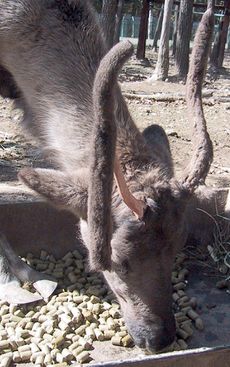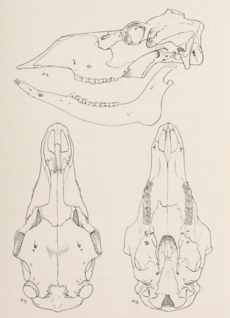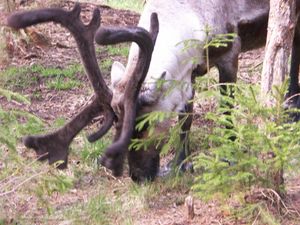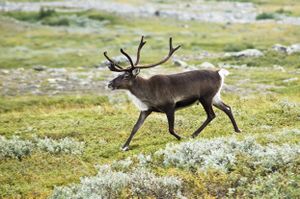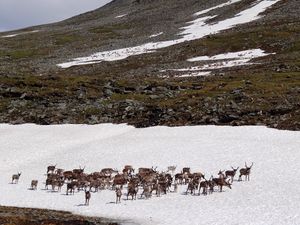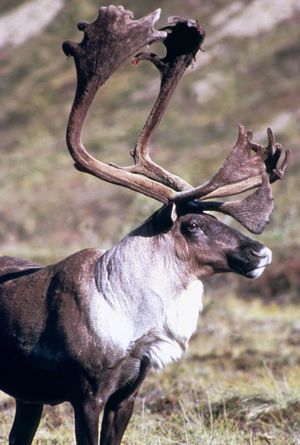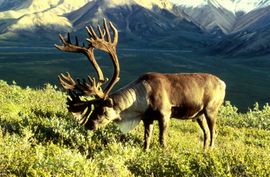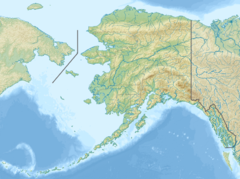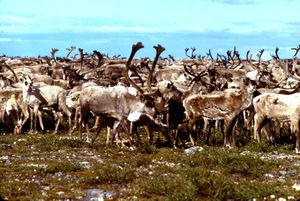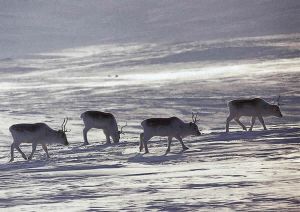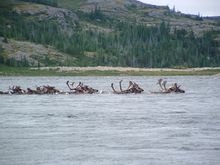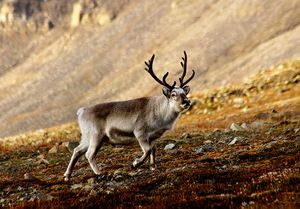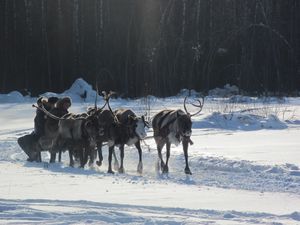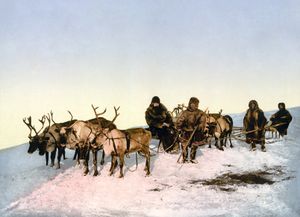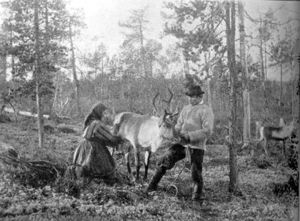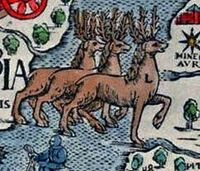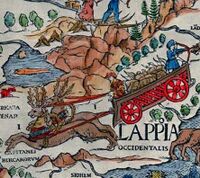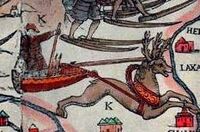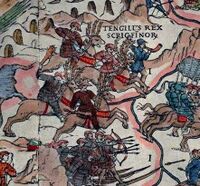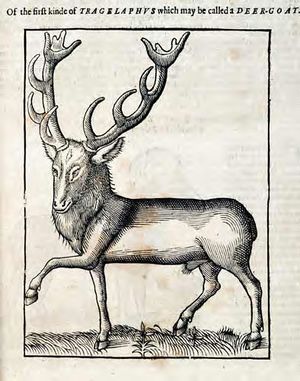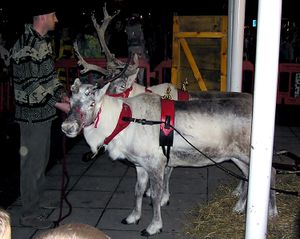رنة
| الرنة Reindeer | |
|---|---|
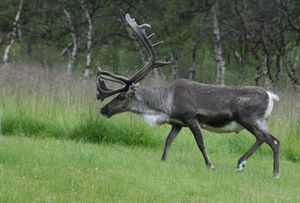
| |
| Reindeer in Norway | |
| التصنيف العلمي | |
| أصنوفة غير معروفة (أصلحها): | Rangifer |
| Species: | Template:Taxonomy/RangiferR. tarandus
|
| Binomial name | |
| Template:Taxonomy/RangiferRangifer tarandus (لينايوس، 1758)
| |
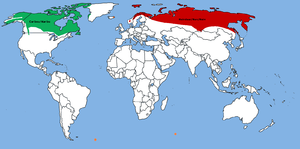
| |
| ينقسم موئل الرنة إلى مناطق في أمريكا الشمالية (الأخضر) وأوراسيا (بالأحمر). | |
| Synonyms | |
|
Cervus tarandus لينايوس، 1758 | |
الرنة (Rangifer tarandus)، ويُعرف أيضاً بالـ كاريبو في أمريكا الشمالية،[3] هي إحدى أنواع الأيائل ذات انتشار شبه قطبي، موطنها الأصلي في المنطقة القطبية الشمالية، المنطقة شبه القطبية، التندرا، المناطق الشمالية والجبلية من شمال أوروپا، سيبيريا وأمريكا الشمالية.[2] ويشمل هذا الأعداد المستوطنة والمهاجرة. يختلف حجم قطيع الرنة بشكل كبير تبعاً للمنطقة الجغرافية. يهاجر قطيع رنة التايمير المهاجر في التندرا السيبرية في روسيا هو أكبر قطعي رنة بري في العالم،[4][5] حيث تتراوح أعداده بين 400.000 و1.000.000 حيوان. ثاني أكبر قطيع رنة هو كاريبو الأحراش الشمالية المهاجر، قطيع نهر جورج في كندا، والذي تتراوح أعداده بين 28.000 و385.000 حيوان. في يناير 2018، كان ترك أكثر من 9.000 حيوان قطيع نهر جورج كما أفادت هيئة الإذاعة الكندية.[6] كما نشرت نيويورك تايمز في أبريل 2018 تقارير مشابهة عن اختفاء قطيع الرنة الجبلي الجنوبي الوحيد في الولايات الـ48 السفلى، ما أطلق عليه أحد الخبراء "الانقراض الوظيفي" بعد تضاءل حجم القطيع ليضم ثلاث حيوانات فقط.[7]
تختلف حيوانات الرنة والجم من الأصغر حجماً، رنة سڤالبارد، إلى الأكبر حجماً، رنة الأحراش الشمالية. ويمتد نطاق انتشارها في أمريكا الشمالية من ألاسكا عبر يوكون، الأراضي الشمالية الغربية ونوناڤوت إلى الغابات الشمالية والجنوب عبر جبال روكي الكندية وجبال كلومبيا وسلكريك.[8] تعيش رنة الأراضي الجرداء، والقنفذية، وپيري في التندرا، بينما تفضل رنة الغابات الشمالية الخجولة الغابات الشمالية. النوعان الرئيسيان في أمريكا الشمالية، رنة پوركوپين ورنة أراضي بارن، تشكلان القطيعين الأكبر وتقومان بهجرات موسمية طويلة من أراضي الميلاد، إلى أراضي المراعي الصيفية والشتوية في التندرا والتايگا. تعتبر هجرات رنة القنفذ من أطول هجرات الثدييات البرية.[8] تتواجد رنة الأراضي الجرداء أيضاً في كيتا بگرينلاند، لكن القطعان الأكبر توجد في ألاسكا، الأراضي الشمالية ونوناڤوت.[9]
The Taimyr herd of migrating Siberian tundra reindeer (R. t. sibiricus) in Russia is the largest wild reindeer herd in the world,[4][5] varying between 400,000 and 1,000,000. What was once the second largest herd is the migratory boreal woodland caribou (R. t. caribou) George River herd in Canada, with former variations between 28,000 and 385,000. As of January 2018, there are fewer than 9,000 animals estimated to be left in the George River herd, as reported by the Canadian Broadcasting Corporation.[10] The New York Times reported in April 2018 of the disappearance of the only herd of southern mountain caribou in the contiguous United States with an expert calling it "functionally extinct" after the herd's size dwindled to a mere three animals.[11] After the last member, a female, was translocated to a wildlife rehab centre in Canada, the caribou is considered extirpated from the Lower 48.[12]
Some subspecies are rare and at least two have already become extinct: the Queen Charlotte Islands caribou of Canada and the Arctic reindeer from East Greenland.[13][14][15] Historically, the range of the sedentary boreal woodland caribou covered more than half of Canada[16] and into the northern states of the contiguous U.S. Woodland caribou have disappeared from most of their original southern range and were designated as threatened in 2002 by the Committee on the Status of Endangered Wildlife in Canada (COSEWIC).[17] Environment Canada reported in 2011 that there were approximately 34,000 boreal woodland caribou in 51 ranges remaining in Canada (Environment Canada, 2011b).[18] Siberian tundra reindeer herds are in decline, and Rangifer tarandus is considered to be vulnerable by the IUCN.
Arctic peoples have depended on caribou for food, clothing, and shelter, such as the Caribou Inuit, the inland-dwelling Inuit of the Kivalliq Region in northern Canada, the Caribou Clan in the Yukon, the Iñupiat, the Inuvialuit, the Hän, the Northern Tutchone, and the Gwichʼin (who followed the Porcupine caribou for millennia). Hunting wild reindeer and herding of semi-domesticated reindeer are important to several Arctic and sub-Arctic peoples such as the Duhalar for meat, hides, antlers, milk, and transportation.[19] The Sámi people (Sápmi) have also depended on reindeer herding and fishing for centuries.[20][21][20] In Sápmi, reindeer are used to pull a pulk,[22] a Nordic sled.
Male and female reindeer can grow antlers annually, although the proportion of females that grow antlers varies greatly between population and season.[23] Antlers are typically larger on males. In traditional Christmas legend, Santa Claus's reindeer pull a sleigh through the night sky to help Santa Claus deliver gifts to good children on Christmas Eve.
في أسطورة الأعياد التقليدية، تجر رنة سانتا كلوز مزلقة عبر السماء المظلمة لتساعد سانتا كلوز على توصيل الهدايا للأطفال المطيعين في ليلة عيد الميلاد.
. . . . . . . . . . . . . . . . . . . . . . . . . . . . . . . . . . . . . . . . . . . . . . . . . . . . . . . . . . . . . . . . . . . . . . . . . . . . . . . . . . . . . . . . . . . . . . . . . . . . . . . . . . . . . . . . . . . . . . . . . . . . . . . . . . . . . . . . . . . . . . . . . . . . . . . . . . . . . . . . . . . . . . . .
التصنيف والتطور
الأنواع الفرعية
حسب كتاب أنواع الثدييات في العالم (الطبعة الثالثة) هناك أربعة عشر نوعاً فرعياً للرنة، منها نوعين منقرضين.[9]
| صورة | النوع الفرعي | الاسم | Sedentary/مهاجر | التقسيم[9] | النطاق | وزن الذكر |
|---|---|---|---|---|---|---|
| R. t. buskensis[24] (1915) | Busk reindeer | Woodland[9] | Russia and the neighbouring regions | No data | ||
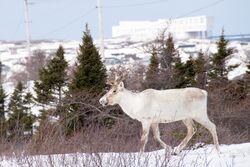 |
R. t. caboti** (G. M. Allen, 1914)[9][Notes 1][25][24] | Labrador caribou | Tundra | Quebec and Labrador, Canada | No data | |
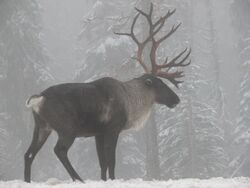 |
R. t. caribou (Gmelin, 1788)[26] | Woodland caribou (includes boreal woodland caribou, migratory woodland caribou and mountain woodland caribou) | Sedentary[Notes 2] | Boreal forest | Southern Canada[27] | Largest North American subspecies |
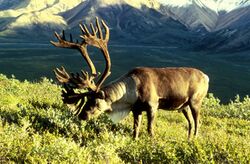 |
R. t. granti (Allen, 1902)[26] | Porcupine caribou or Grant's caribou | Migratory | Tundra | Alaska, the United States and the Yukon, Canada | |
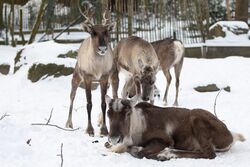 |
R. t. fennicus (Lönnberg, 1909) | Finnish forest reindeer | Woodland[9] | Northwestern Russia and Finland[22][27] | 150–250 kg (330–550 lb) | |
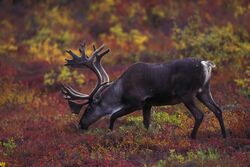 |
R. t. groenlandicus (Borowski, 1780)[26] | Barren-ground caribou | Migratory | Tundra | The High Arctic islands of Nunavut and the Northwest Territories, Canada and western Greenland | 150 kg (330 lb) |
| R. t. osborni** (Allen, 1902)[Notes 1][25][24] | Osborn's caribou | Woodland | British Columbia, Canada | No data | ||
| R. t. pearsoni (Lydekker, 1903)[24] | Novaya Zemlya reindeer | Island subspecies make local movements | The Novaya Zemlya archipelago of Russia[27] | No data | ||
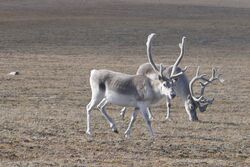 |
R. t. pearyi (Allen, 1902)[26] | Peary caribou | Island subspecies make local movements | The High Arctic islands of Nunavut and the Northwest Territories, Canada[27] | Smallest North American subspecies | |
| R. t. phylarchus (Hollister, 1912)[24] | Kamchatkan reindeer | Woodland[9] | The Kamchatka Peninsula and the regions bordering the Sea of Okhotsk, Russia[27] | No data | ||
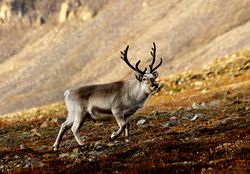 |
R. t. platyrhynchus (Vrolik, 1829) | Svalbard reindeer | Island subspecies make local movements | The Svalbard archipelago of Norway[27] | Smallest subspecies | |
| R. t. sibiricus (Murray, 1866)[24] | Siberian tundra reindeer | Tundra | Siberia and Russia[27] (Franz Josef Land during the Holocene from >6400-1300 cal. BP (locally extinct)) [28] | No data | ||
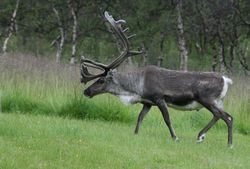 |
R. t. tarandus (Linnaeus, 1758) | Mountain reindeer or Norwegian reindeer | Tundra or mountain | The Arctic tundra of the Fennoscandian Peninsula in Norway[22][27] and Austfirðir in Iceland (introduced)[29] | No data | |
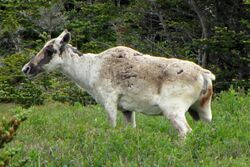 |
R. t. terraenovae** (Bangs, 1896)[9][Notes 1][25][24] | Newfoundland caribou | Woodland | Newfoundland, Canada | No data | |
| R. t. valentinae**[9] | Siberian forest reindeer | Boreal forest | The Ural Mountains, Russia and the Altai Mountains, Mongolia[27] | No data |
| Subspecies | Name | Sedentary/migratory | Division | Range | Weight of male | Extinct since |
|---|---|---|---|---|---|---|
| R. t. dawsoni (Thompson-Seton, 1900)[26] | †Queen Charlotte Islands caribou or Dawson's caribou | Extinct | Woodland | Graham Island of the Queen Charlotte Islands archipelago, off the coast of British Columbia, Canada | No data | 1908 |
| R. t. eogroenlandicus (Degerbøl, 1957)[15] | †East Greenland caribou or Arctic reindeer | Extinct | Tundra | Eastern Greenland | No data | 1900 |
The table above includes R. tarandus caboti (the Labrador caribou), R. tarandus osborni (Osborn's caribou – from British Columbia) and R. tarandus terraenovae (the Newfoundland caribou). Based on a review in 1961,[26] these were considered invalid and included in R. tarandus caribou, but some recent authorities have considered them all valid, even suggesting that they are quite distinct.[25][24] An analysis of mtDNA in 2005 found differences between the caribou from Newfoundland, Labrador, southwestern Canada and southeastern Canada, but maintained all in R. tarandus caribou.[30]
There are seven subspecies of reindeer in Eurasia, of which only two are found in Fennoscandia: the mountain reindeer (R. t. tarandus) in Norway, Sweden, Finland, and Russia and the Finnish forest reindeer (R. t. fennicus) in Finland and Russia.[22]
Two subspecies are found only in North America: the Porcupine caribou (R. t. granti) and the Peary caribou (R. t. pearyi). The barren-ground caribou (R. t. groenlandicus) is found in western Greenland, but the larger herds are in Alaska, the Northwest Territories and Nunavut.[9]
According to Grubb, based on Banfield[26] and considerably modified by Geist,[31] these subspecies and divisions are considered valid:[9] the caribou or woodland caribou division, which includes R. t. buskensis, R. t. caribou, R. t. dawsoni, R. t. fennicus, R. t. phylarchus and R. t. valentinae (R. t. osborni is a transitional subspecies between the caribou and tarandus divisions), the tarandus or tundra reindeer division, which includes R. t. caboti, R. t. groenlandicus, R. t. pearsoni, R. t. sibiricus and R. t. terraenovae and the platyrhynchus or dwarf reindeer division, which includes R. t. pearyi and R. t. platyrhynchus.
Some of the Rangifer tarandus subspecies may be further divided by ecotype depending on several behavioural factors – predominant habitat use (northern, tundra, mountain, forest, boreal forest, forest-dwelling, woodland, woodland (boreal), woodland (migratory) or woodland (mountain), spacing (dispersed or aggregated) and migration patterns (sedentary or migratory).[32][33][34]
The "glacial-interglacial cycles of the upper Pleistocene had a major influence on the evolution" of Rangifer tarandus and other Arctic and sub-Arctic species. Isolation of Rangifer tarandus in refugia during the last glacial – the Wisconsin in North America and the Weichselian in Eurasia-shaped "intraspecific genetic variability" particularly between the North American and Eurasian parts of the Arctic.[3]
In 1986 Kurtén reported that the oldest reindeer fossil was an "antler of tundra reindeer type from the sands of Süssenborn" in the Pleistocene (Günz) period (680,000 to 620,000 BP).[1] By the 4-Würm period (110,000–70,000 to 12,000–10,000 BP) its European range was very extensive. Reindeer occurred in
... Spain, Italy, and southern Russia. Reindeer [was] particularly abundant in the Magdalenian deposits from the late part of the 4-Wurm just before the end of the Ice Age: at that time and at the early Mesolithic it was the game animal for many tribes. The supply began to get low during the Mesolithic, when reindeer retired to the north.
— Kurtén 1968:170
"In spite of the great variation, all the Pleistocene and living reindeer belong to the same species."[1]
Humans started hunting reindeer in the Mesolithic and Neolithic periods and humans are today the main predator in many areas. Norway and Greenland have unbroken traditions of hunting wild reindeer from the last glacial period until the present day. In the non-forested mountains of central Norway, such as Jotunheimen, it is still possible to find remains of stone-built trapping pits, guiding fences and bow rests, built especially for hunting reindeer. These can, with some certainty, be dated to the Migration Period, although it is not unlikely that they have been in use since the Stone Age.[بحاجة لمصدر]
الخصائص البدنية
القرون
. . . . . . . . . . . . . . . . . . . . . . . . . . . . . . . . . . . . . . . . . . . . . . . . . . . . . . . . . . . . . . . . . . . . . . . . . . . . . . . . . . . . . . . . . . . . . . . . . . . . . . . . . . . . . . . . . . . . . . . . . . . . . . . . . . . . . . . . . . . . . . . . . . . . . . . . . . . . . . . . . . . . . . . .
الجري
التبادل الحراري
الحوافر
الحجم
صوت النقر
العينان
علم الأحياء والسلوك
النظام الغذائي
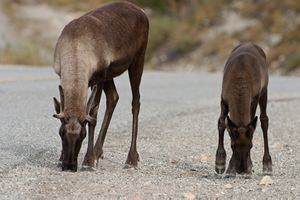
الرنة هي من الحيوانات المجترة.ويتكون معدتها من اربع غرف تسمح له بأكل النبتات الكثيفة. يتناول الاشنات أساسا وخاصة الرنة اكلة الطحالب وتأكل الصفصاف والبتوالات والسعادى والعوسج وهناك ادلة تقول انه يستطيع اكل بيض الطيور والفطر في اواخر الصيف.
التكوين الجسماني الموسمي
التكاثر ودورة الحياة
التزاوج يحدث في أواخر سبتمبر إلى أوائل نوفمبر. ليتقاتل ذكرين على الانثى ومن يفوز يحظى بها وتتوقف الذكور عن الاكل في هذه المدة لفقد احتياطاتيها. تلد العجول في مايو أو يونيو بعد 45 يوما. تبدأ العجول باكل العلف والنبات ولكنها تبقى ترضع حتى ولادة العجل التالي.
البنية الاجتماعية، الهجرة والنطاق
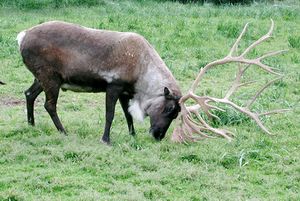
علم البيئة
الانتشار والموئل
الرنة يتواجد على نطاق واسع، في الأصل، تم العثور على حيوان الرنة في الدول الإسكندنافية وأوروبا الشرقية وروسيا، ومنغوليا، وشمال الصين إلى الشمال من خط العرض 50th. في أمريكا الشمالية، وجد في كندا والولايات المتحدة الأمريكية في الحدود الشمالية من واشنطن إلى ولاية ماين. في القرن 19th لا تزال موجودة في جنوب ولاية أيداهو. كما أنه يتواجد بصورة طبيعية على جزيرة سخالين، وغرينلاند،
خلال أواخر عصر البليستوسين، تم العثور على حيوان الرنة جنوب الولايات المتحدة حتى ولاية نيفادا وتينيسي في أمريكا الشمالية وإسبانيا في أوروبا. واليوم، الرنة البرية قد اختفت من مناطق عديدة ضمن هذا النطاق، وخاصة من الجزء الجنوبي منها، حيث اختفت تقريبا في كل مكان. أعداد كبيرة من الرنة البرية لا تزال موجودة في النرويج، وسيبيريا وغرينلاند وألاسكا وكندا، مع قطيع ما يقرب من 50 حيوان الرنة الذي يعيش في جميع أنحاء المنطقة Cairngorm في اسكتلندا.
الرنة المستأنسة توجد في الغالب في إسكندنافيا وشمال روسيا. آخر ما تبقى من الرنة البرية في أوروبا توجد في أجزاء من جنوب النرويج.
. . . . . . . . . . . . . . . . . . . . . . . . . . . . . . . . . . . . . . . . . . . . . . . . . . . . . . . . . . . . . . . . . . . . . . . . . . . . . . . . . . . . . . . . . . . . . . . . . . . . . . . . . . . . . . . . . . . . . . . . . . . . . . . . . . . . . . . . . . . . . . . . . . . . . . . . . . . . . . . . . . . . . . . .
المفترسون
تهديدات أخرى
حسب البلد
روسيا
أمريكا الشمالية
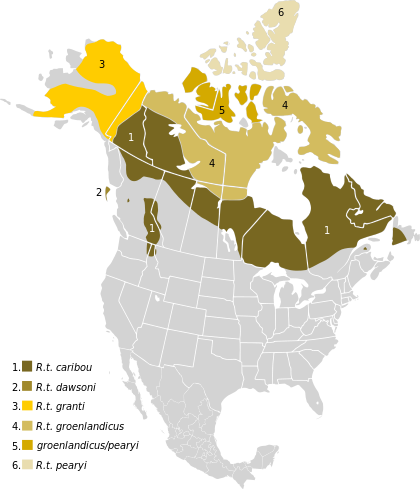
الولايات المتحدة
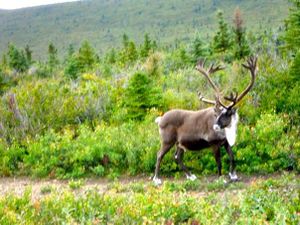
كندا
النرويج
رنة سڤالبارد
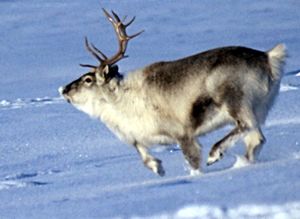
فنلندا
آيسلندا
تجربة الأراضي البريطانية وراء البحار
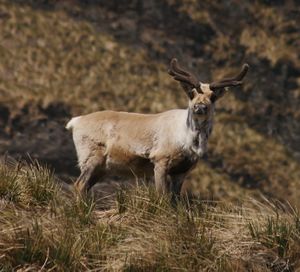
تجربة الأراضي الفرنسية وراء البحار
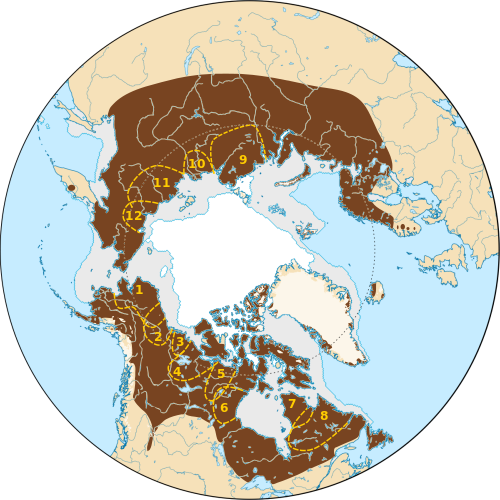
الحفاظ
العلاقة بالبشر
الرنة والشعوب الأصلية
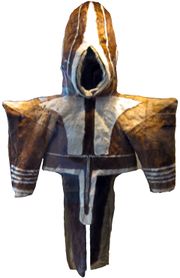
تربية الرنة
Currently, many reindeer herders are heavily dependent on diesel fuel to provide for electric generators and snowmobile transportation, although solar photovoltaic systems can be used to reduce diesel dependency.[37]
- منمنمات للرنة من خريطة أولاوس ماگنس في 1539، المسماة كارتا مارينا
في التاريخ
رنة سانتا كلوز
في الأساطير والفن
شعارات النبالة والرموز
انظر أيضاً
الطفيليات
الهوامش
قراءات إضافية
- "Caribou Census Complete: 325,000 animals" (PDF), Caribou Trails: News from the Western Arctic Caribou Herd Working Group (Nome, Alaska), August 2012, http://westernarcticcaribou.org/wp-content/uploads/2012/08/CT2012_FINAL_0628_lowresolution.pdf, retrieved on 14 January 2014 This 15 page well-illustrated and highly informative August 2012 edition of the Western Arctic Caribou organization newsletter, reported the 2011 census results of the WACH, which is Alaska's largest caribou herd.
المصادر
- ^ أ ب ت Kurtén, Björn (1968). Pleistocene Mammals of Europe. Transaction Publishers. pp. 170–177. ISBN 978-1-4128-4514-4. Archived from the original on 1 يناير 2014. Retrieved 6 أغسطس 2013.
{{cite book}}: Unknown parameter|deadurl=ignored (|url-status=suggested) (help) خطأ استشهاد: وسم<ref>غير صالح؛ الاسم "Kurt" معرف أكثر من مرة بمحتويات مختلفة. - ^ أ ب Gunn, A. (2016). "Rangifer tarandus". IUCN Red List of Threatened Species. 2016: e.T29742A22167140. Archived from the original on 29 يونيو 2016. Retrieved 24 يوليو 2016.
{{cite journal}}: Unknown parameter|deadurl=ignored (|url-status=suggested) (help) - ^ أ ب Flagstad, Oystein; Roed, Knut H (2003). "Refugial origins of reindeer (Rangifer tarandus L) inferred from mitochondrial DNA sequences" (PDF). Evolution. 57 (3): 658–670. doi:10.1554/0014-3820(2003)057[0658:roorrt]2.0.co;2. PMID 12703955. Archived from the original (PDF) on 4 September 2006. Retrieved 4 January 2013.
- ^ أ ب Russell, D.E.; Gunn, A. (20 November 2013). "Migratory Tundra Rangifer". NOAA Arctic Research Program.
{{cite journal}}: Cite journal requires|journal=(help) - ^ أ ب Kolpasсhikov, L.; Makhailov, V.; Russell, D. E. (2015). "The role of harvest, predators, and socio-political environment in the dynamics of the Taimyr wild reindeer herd with some lessons for North America" (PDF). Ecology and Society. 20. doi:10.5751/ES-07129-200109.
- ^ "Tradition 'snatched away': Labrador Inuit struggle with caribou hunting ban | CBC News". CBC (in الإنجليزية الأمريكية). Retrieved 2018-04-18.
- ^ Robbins, Jim (2018-04-14). "Gray Ghosts, the Last Caribou in the Lower 48 States, Are 'Functionally Extinct'". The New York Times (in الإنجليزية الأمريكية). ISSN 0362-4331. Retrieved 2018-04-18.
- ^ أ ب خطأ استشهاد: وسم
<ref>غير صحيح؛ لا نص تم توفيره للمراجع المسماةEder2011 - ^ أ ب ت ث ج ح خ د ذ ر ز Grubb, Peter (2005), Rangifer tarandus, Archived from the original on 16 January 2014, https://web.archive.org/web/20140116130837/http://www.vertebrates.si.edu/msw/mswcfapp/msw/taxon_browser.cfm?msw_id=12727, retrieved on 15 January 2014
- ^ "Tradition 'snatched away': Labrador Inuit struggle with caribou hunting ban | CBC News". CBC (in الإنجليزية الأمريكية). Retrieved 18 April 2018.
- ^ Robbins, Jim (14 April 2018). "Gray Ghosts, the Last Caribou in the Lower 48 States, Are 'Functionally Extinct'". The New York Times (in الإنجليزية الأمريكية). ISSN 0362-4331. Retrieved 18 April 2018.
- ^ "Woodland caribou".
- ^ Peter Gravlund; Morten Meldgaard; Svante Pääbo & Peter Arctander (1998). "Polyphyletic Origin of the Small-Bodied, High-Arctic Subspecies of Tundra Reindeer (Rangifer tarandus)". Molecular Phylogenetics and Evolution. 10 (2): 151–9. doi:10.1006/mpev.1998.0525. PMID 9878226.
- ^ خطأ استشهاد: وسم
<ref>غير صحيح؛ لا نص تم توفيره للمراجع المسماةdawsoni - ^ أ ب Degerbøl Magnus (1957). "The extinct reindeer of East-Greenland: Rangifer tarandus eogroenlandicus, subsp. nov.: compared with reindeer from other Arctic regions". Acta Arctica. 10: 1–57.
- ^ "Population Critical: How are Caribou Faring?" (PDF). Canadian Parks and Wilderness Society and The David Suzuki Foundation. December 2013. Archived from the original (PDF) on 19 December 2013. Retrieved 17 December 2013.
- ^ Designatable Units for Caribou (Rangifer tarandus) in Canada, Ottawa, Ontario, 2011, p. 88, http://www.cosewic.gc.ca/eng/sct12/COSEWIC_Caribou_DU_Report_23Dec2011.pdf, retrieved on 18 December 2013
- ^ Evaluation of Programs and Activities in Support of the Species at Risk Act, 24 September 2012, pp. 2, 9, http://www.ec.gc.ca/ae-ve/6AE7146E-0991-4C2F-BE2F-E89DF4F8ED1E/13-018_EC_ID_1568_PDF_accessible_ANG.pdf, retrieved on 27 December 2013
- ^ "In North America and Eurasia the species has long been an important resource—in many areas the most important resource—for peoples inhabiting the northern boreal forest and tundra regions." (Banfield 1961:170; Kurtén 1968:170)Ernest S. Burch Jr. (1972). "The Caribou/Wild Reindeer as a Human Resource". American Antiquity. 37 (3): 339–368. doi:10.2307/278435. JSTOR 278435.
- ^ أ ب Atlas of Murmansk Oblast, 1971
- ^ Administrative-Territorial Divisions of Murmansk Oblast
- ^ أ ب ت ث "The Sámi and their reindeer". Austin, Texas: University of Texas. Archived from the original on 23 July 2013. Retrieved 15 January 2014.
- ^ Schaefer, J. A.; Mahoney, S. P. (2001). "Antlers on female caribou: biogeography of the bones of contention". Ecology. 82 (12): 3556–3560. doi:10.1890/0012-9658(2001)082[3556:aofcbo]2.0.co;2. JSTOR 2680172.
- ^ أ ب ت ث ج ح خ د قالب:MSW3 Grubb
- ^ أ ب ت ث Geist, V. (2007). "Defining subspecies, invalid taxonomic tools, and the fate of the woodland caribou". Rangifer. 27 (4): 25. doi:10.7557/2.27.4.315.
- ^ أ ب ت ث ج ح خ خطأ استشهاد: وسم
<ref>غير صحيح؛ لا نص تم توفيره للمراجع المسماةBanfield_1961 - ^ أ ب ت ث ج ح خ د ذ Mattioli, S. (2011). Caribou (Rangifer tarandus). pp. 431–432 in: Handbook of the Mammals of the World Vol. 2. Lynx Edicions, Barcelona. ISBN 978-84-96553-77-4
- ^ Forman, S. L.; Lubinski, D.; Weihe, R. R. (2000). "The Holocene occurrence of reindeer on Franz Josef Land, Russia". The Holocene. 10 (6): 763–768. Bibcode:2000Holoc..10..763F. doi:10.1191/09596830095015. S2CID 140183093.
- ^ "Reindeer In Iceland". Tinna Adventure (in الإنجليزية الأمريكية). 2017-02-13. Retrieved 2019-09-09.
- ^ Cronin, M. A.; MacNeil, M. D.; Patton, J. C. (2005). "Variation in Mitochondrial Dna and Microsatellite Dna in Caribou (Rangifer tarandus) in North America". Journal of Mammalogy. 86 (3): 495–505. doi:10.1644/1545-1542(2005)86[495:VIMDAM]2.0.CO;2.
- ^ Geist, Valerius (1998), Deer of the world: their evolution, behavior, and ecology, Mechanicsburg, PA: Stackpole Books, ISBN 9780811704960, https://books.google.com/books?id=bcWZX-IMEVkC
- ^ Bergerud, A. T. (1996). "Evolving perspectives on caribou population dynamics, have we got it right yet?". Rangifer. 16 (Special Issue 9): 95. doi:10.7557/2.16.4.1225.
- ^ Festa-Bianchet, M.; Ray, J.C.; Boutin, S.; Côté, S.D.; Gunn, A.; et al. (2011). "Conservation of Caribou (Rangifer tarandus) in Canada: An Uncertain Future". Canadian Journal of Zoology. 89 (5): 419–434. doi:10.1139/z11-025.
- ^ Mager, Karen H. (2012). "Population Structure and Hybridization of Alaskan Caribou and Reindeer: Integrating Genetics and Local Knowledge" (PDF). Fairbanks, Alaska: PhD dissertation, University of Alaska Fairbanks. Archived from the original (PDF) on 28 December 2013. Retrieved 27 December 2013.
- ^ خطأ استشهاد: وسم
<ref>غير صحيح؛ لا نص تم توفيره للمراجع المسماةwalker - ^ خطأ استشهاد: وسم
<ref>غير صحيح؛ لا نص تم توفيره للمراجع المسماةNorthAmerica - ^ Obydenkova, Svetlana V.; Pearce, Joshua M. (2016). "Technical viability of mobile solar photovoltaic systems for indigenous nomadic communities in northern latitudes" (PDF). Renewable Energy. 89: 253–267. doi:10.1016/j.renene.2015.12.036.
المراجع
- "Designatable Units for Caribou (Rangifer tarandus) in Canada" (PDF). COSEWIC. Ottawa, Ontario: Committee on the Status of Endangered Wildlife in Canada. 2011. Archived from the original (PDF) on 3 مارس 2016. Retrieved 18 ديسمبر 2013.
{{cite web}}: Unknown parameter|deadurl=ignored (|url-status=suggested) (help)
وصلات خارجية
- The Reindeer Portal, Source of Information About Reindeer Husbandry Worldwide
- 1935 Reindeer Herding in the Northwest Territories
- General information on Caribou and Reindeer
- Human Role in Reindeer/Caribou Systems
- Reindeer hunting as World Heritage – a ten-thousand-year-long tradition
- Reindeer Research Program – Alaska reindeer research and industry development
- Adaptations To Life In The Arctic – Instructional slide-show, University of Alaska
- Rangifer – world's only scientific journal dealing exclusively with husbandry, management and biology of Arctic and northern ungulates
- Rangifer tarandus on the IUCN Red List
 Texts on Wikisource:
Texts on Wikisource:
- "Caribou". Encyclopedia Americana. 1920.
- Lydekker, Richard (1911). . In Chisholm, Hugh (ed.). دائرة المعارف البريطانية (eleventh ed.). Cambridge University Press.
{{cite encyclopedia}}: Cite has empty unknown parameter:|coauthors=(help) - "Reindeer". New International Encyclopedia. 1905.
- Puckett, Catherine; Landis, Ben (December 15, 2014). "The Other 364 Days of the Year: The Real Lives of Wild Reindeer Categories: Biology and Ecosystems". U.S. Geological Survey.
- "Reference Article: Reindeer (caribou)". ScienceDaily. Retrieved December 25, 2015.
وصلات خاصة برنا أمريكا الشمالية
- Frequently Asked Questions about Caribou from the Arctic National Wildlife Refuge
- Caribou and You – Campaign by CPAWS to protect the woodland caribou, a species at risk in Canada
- Newfoundland Five-Year Caribou Strategy Seeks to Address Declining Populations
- CS1 errors: unsupported parameter
- CS1 الإنجليزية الأمريكية-language sources (en-us)
- Articles with hatnote templates targeting a nonexistent page
- IUCN Red List vulnerable species
- Automatic taxobox cleanup
- Articles with unsourced statements from May 2012
- مقالات المعرفة المحتوية على معلومات من دائرة المعارف البريطانية طبعة 1911
- مطبخ ألاسكي
- ثدييات وصفت في 1758
- حيوانات برية قطبية
- أيائل
- ثدييات القطب الشمالي
- Holarctic fauna
- ماشية
- ثدييات آسيا
- ثدييات كندا
- ثدييات گرينلاند
- ثدييات أوروپا
- ثدييات روسيا
- ثدييات الولايات المتحدة
- Pack animals
- رنة


